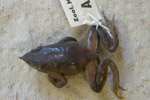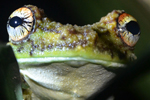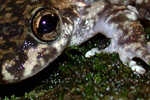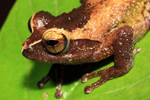A frightening disease has been ravaging amphibians across the planet. At least 350 species have been infected, two hundred of which have suffered massive population reductions or extinctions, some even occurring within the space of weeks. In 1999, a single fungal species called Batrachochytrium dendrobatidis (Bd), commonly known as the chytrid fungus, was identified as the causative agent for these rapid die-offs. This facilitated preemptive testing of rare or endangered amphibian populations for Bd, the early detection of which allowed scientists to establish captive breeding populations to stem amphibian species extinctions. Frighteningly, despite this discovery, there remain perplexing instances of rapid amphibian deaths that do not test positive for Bd.

A Limosa Harlequin Frog (Atelopus limosus) succumbs to a Bd infection at Sierra Llorona in Panama. Photo credit Brian Gratwicke, Smithsonian Conservation Biology Institute.
An Martel of Ghent University, in the journal PNAS, has recently reported a possible explanation for these mysterious deaths. Together with an international team of scientists, she has identified a second culprit: a new chytrid species named Batrachochytrium salamandrivorans (Bs), which can be translated to “the salamander-eating fungus.”
Fire salamanders (Salamandra salamandra) are captivating creatures, jet black with vibrant yellow patterns that vary from spots to stripes. One of the last surviving populations of this species is found in Bunderbos in the southern Netherlands. In 2010, when the salamanders here first began to die, herpetologists barely had time to react before sightings dropped from 200 to 4 in one year. By 2012, nearly 96% of all salamanders present when assessed in 1997 were gone.
 A fire salamander (Salamandra salamandra) endemic to central Europe. Photo credit: Kenny De Boeck
A fire salamander (Salamandra salamandra) endemic to central Europe. Photo credit: Kenny De Boeck
Although currently listed as Least Concern by the IUCN Red List, fire salamanders are threatened in many parts of their range across Europe. While they have suffered greatly from habitat loss through the drying up of streams, nothing decimated their populations like this mysterious disease. Fearing the worst, scientists captured 39 individuals to establish a breeding program, only for 19 animals (nearly half) to promptly die in captivity. Post-mortems were conducted on these animals, and they were tested for Bd and a host of other amphibian diseases, but to no avail. However, further experimentation by Martel and colleagues then revealed the presence of a fungal chytrid species called Bs, closely related to Bd but previously unknown to science. It is the only chytrid species, other than Bd, known to prey on invertebrates.
“The discovery of Batrachochytrium salamandrivorans (Bs) is very significant because it is a new species of a deadly amphibian pathogen and was undetectable using previous methods. Its discovery suggests that this, or other undescribed Batrachiochytrium species could be responsible for amphibian declines, but we have been missing them using current detection methods,” explains Brian Gratwicke, a conservation biologist at the Smithsonian Zoo in charge of efforts to stem global declining amphibian populations.
Martel and colleagues have developed a sensitive DNA test for this new strain, which can detect Bs in swabs of the lesions of infected individuals. Remarkably, when Bs was used to infect midwife toads (which are the most sensitive of all European amphibian species to Bd), they did not contract the disease at all. Such variability lends hope that Bs will be restricted to the fire salamanders, but if it is anything like Bd, this could be wishful thinking. Martel strongly advises that all amphibian monitoring programs test for Bs, and other scientists agree.
“There are several unexplained declines of amphibians that have not been connected to Bd,” Gratwicke told mongabay.com. “In one case, we are examining the effects of climate change as a possible factor explaining current declines of hellbenders and other salamanders in the Eastern United States. It would certainly be interesting to do some prospecting in this region for Bs and other Batrachochytrium species. Our pathologists have always advocated that we should continue to examine histopathology in enigmatic decline situations, rather than relying solely on swab results. This study is a great example of why we should always heed their advice.”
The future of fire salamanders isn’t entirely bleak. In 2000, the Smithsonian National Zoo pioneered a treatment for amphibians infected with Bd – a series of baths in the antifungal drug, itraconazole. Martel and colleagues have used a similar drug, voriconazole, to successfully treat fire salamanders with Bs infections. Although this cure exists, researchers have shown that surviving an infection of Bd does not render an amphibian immune to subsequent exposures to the same disease. Not only does this rule out a vaccine for the disease, but it also means the source of the fungus will have to be eradicated before reintroduction programs of the fire salamanders can begin.
Martel also reports that Bs survives at much lower temperatures than Bd, from 10 to 15 degrees Celsius, which suggests that tropical amphibian populations might not be at risk of encountering this new chytrid. In fact, heat has been suggested as a potential solution to Bd infections, since frogs with warmer body temperatures (from residing in warmer streams, or spending more time sunning) are less likely to become infected.
While it is tempting to think that a nice hot bath will save the fire salamanders, habitat destruction and climate change remain the largest killers of amphibians the world over. The present critical condition of nearly half of all amphibians worldwide is further threatened by chytrid fungal species, due to their ability to rapidly decimate amphibian populations already teetering on the brink of extinction.

The global distribution of the amphibian chytrid fungus, Batrachochytrium dendrobatidis (Bd) assessed in 2013. Image credit: Olson et al. (2013) The authors of the study reported that the new chytrid species causes lesions with marked skin ulceration that can be fatal from within seven to eighteen days of infection. When healthy animals were exposed to infected animals, they contracted the disease and died within 22 to 27 days. With such a high level of transmission, and no known natural immunity to the disease, it is no wonder the fire salamanders have succumbed.
References:
Martel A, Spitzen-van der Sluijs A, Blooia M, Bert W, et al. (2013) Batrachochytrium salamandrivorans sp. nov. causes lethal chytridiomycosis in amphibians. PNAS published ahead of print September 3, 2013, doi:10.1073/pnas.1307356110
Olson DH, Aanensen DM, Ronnenberg KL, Powell CI, et al. (2013) Mapping the Global Emergence of Batrachochytrium dendrobatidis, the Amphibian Chytrid Fungus. PLoS ONE 8(2): e56802. doi:10.1371/journal.pone.0056802
Spitzen-van der Sluijs A, Spikmans F, Bosman W, de Zeeuw M, et al. (2013) Rapid Enigmatic Decline Drives the Fire Salamander (Salamandra salamndra) to the Edge of Extinction in the Netherlands. Amphibia-Reptilia 34 (2013): 233-239
Related articles
Vocal-sac breeding frog possibly extinct

(07/02/2013) Somewhere in the wet pine forests of Chile, a male frog is gulping-up a bunch of eggs. No he’s not eating them, he’s just being a good dad. Darwin’s frogs are known for their unique parenting-style: tadpoles are incubated in the vocal sac of the father. First recorded by Charles Darwin during his world famous voyage aboard the Beagle, the amphibians were common in the native Chilean pine forests until the last few decades. Now, scientists believe that one of the two species, the northern Darwin’s frog (Rhinoderma rufum), may have vanished for good. And the other is hanging on by a thread.
Amazonian students help monitor threatened frog populations

(07/01/2013) According to the International Union for Conservation of Nature, amphibians are the most threatened group of animals on Earth: currently around 30 percent of the world’s amphibians are listed as threatened with extinction. However this percentage doesn’t include those species about which too little is known to evaluate (26 percent). Amphibians face many threats but two of the largest are habitat loss and the lethal chytrid fungus, which has rapidly spread worldwide and is likely responsible for numerous extinctions. But conservationists are coming up with innovative and creative ways to keep amphibians from disappearing, including a program from the Detroit Zoological Society (DZS) that is working with students in the Peruvian Amazon to monitor frog populations.
Turning up the temperature might save frogs’ lives

(05/28/2013) Over the past 30 years, amphibians worldwide have been infected with a lethal skin disease known as the amphibian chytrid fungus (Batrachochytrium dendrobatidis). “The disease can cause rapid mortality, with infected frogs of susceptible species dying within weeks of infection in the laboratory.” Jodi Rowley, a herpetologist with the Australian Museum told mongabay.com. “This disease has now been associated with declines and extinctions in hundreds of species of amphibians worldwide, and is a serious threat to global amphibian biodiversity.”
Scientists discover 8 new frogs in one sanctuary, nearly all Critically Endangered (photos)

(03/21/2013) Two surveys in the mountainous forests of Sri Lank’s Peak Wilderness Sanctuary have uncovered eight new species of frogs, according to a massive new paper in the Journal of Threatened Taxa. While every year over a hundred new amphibians are discovered, eight new discoveries in a single park is especially notable. Sri Lanka is an amphibian-lovers paradise with well over 100 described species, most of which are endemic, i.e. found only on the small island country. Unfortunately the country has also seen more frog extinctions than anywhere else, and seven of the eight new species are already thought to be Critically Endangered.